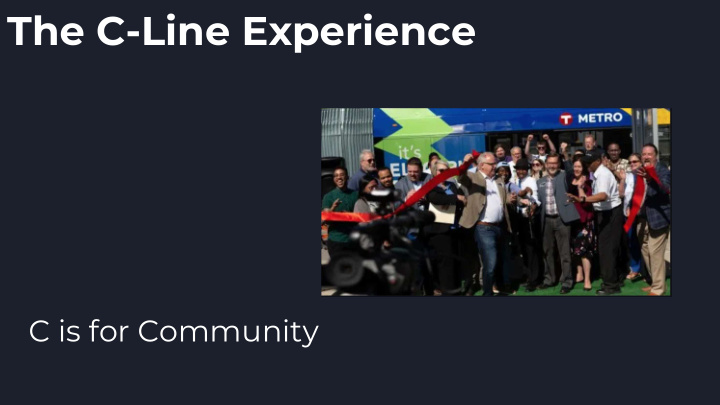



The C-Line Experience C is for Community
Neese Parker Artist Youthprise Youth Engagement Manager Community Advocate
Summarized Research Summary (This will be fast so read my handout! they gave me 10 minutes .) Full summary is in your handout. Methods: 1. Interviews: a. Community members and Met and City Council Members b. Ages 16-50 c. 90% Indigenous and/or People of Color 2. Literature Review 3. Data from Metropolitan Council
Analysis Summary Districts 7 and 8 has had a large growth in terms of construction and population. 100% of Interviewees voiced concerns about the gentrification in these districts. Main Theme Long-term Residents of historically disinvested neighborhoods communicated that gentrifying neighbors carry cultural power and privilege that they use and it impacts in two key ways: New “gentrifying neighbors” communicate that they feel ● unsafe and see long-term residents as threats (ex: calling 911/311 on BBQ smoke or people “loitering in their own yard”). A sense that new gentrifying neighbors are causing more harm ● than good.
Gentrification ...there are individuals who face negative effects due to gentrification. There will be some renters that no longe are Despite the belief of some that capable of paying the rent and will be their are positive effects of displaced. gentrification has for homeowners, landlords and middle class In terms of education, low income families are individuals, Marilyn Pineda at the displaced and that means changing the UMass Boston has shared on the school the child goes to… topic... Research has found that the people that are migrating into the gentrified neighborhoods are primarily white, professionals and single parents, and it is the lower to working class, elderly and unemployed that are being displaced.”
Impacts of Gentrification is the Root of Three Major Themes 1. Fear of community members, encouraging isolation and further social separation 1. Community resources are modified to feel exclusive no longer welcoming to long- term residents 1. Loss affordable home/land ownership
Re-Recommending With The Met-Council City Planning Water Management Housing and Parks Metro Transit Challenge: The process of the City Planning system makes it hard to implement new ideas that address community issue s.
Big Ideas! C is for Community - App Pay for bus fair - Use your phone instead of you go-to card - Reduce the use of plastic/paper - Employers can deposit funds into your C-app account to support and incentivize transportation benefits C-Line Community Representatives - Super users can register as a community representative and schedule events to host on the c-line - App will show upcoming community events on and off the C-Line C-cash gives you free rides through App Engagement - Earn “cash” by becoming a frequent rider - Participating in c-line events - Participating in Met Council community engagement on plans, policies, and projects
Recommendations 1. Invest into more first time home/landowner programs specified for long-term residents at risk of displacement stabilizing communities. a. Allow for informational representatives to ride buses to provide information inspired by “Mad Dads” program but for land and home ownership opportunities 1. Invest into more shared community spaces (community gardens, parks and trails) 2. Provide more opportunities for community events (e.i. Block parties, movies in the parks) a. Provide informational pamphlets at bus stops and on busses to inform community members about community events, farmers markets and park guides 1. Invest into community workshops (e.i. Cooking, financial literacy) a. Allow for community facilitators to utilize the space of metro transit (with rider’s consent) to act as community researchers, informers and advocates. (i.e. appetite for change giving information sessions, YPAR groups gathering interviews, and rides with financial advisors) 1. Provide space for cross cultural learning (informational podiums at parks, community history teaching and neighborhood trainings) a. Use bus design (outside visuals) to provide historical and local information about the communities of color in Minneapolis. (i.e. facts about Ojibwe and Dakota history, hmong cultural contributions to the city and black owned businesses in the area.)
Final Thoughts 1. Transit, Parks, and Development all play a role in gentrification, so the Met Council has many opportunities to increase equity and address the negative impacts of gentrification. 2. The way planning and governmental systems work are too inflexible and not responsive enough to our dynamic community needs. These systems need to change. 3. Don’t let our work and time be in vain. 4. Please look at the packet, I am available to talk more, hit me up!
Recommend
More recommend